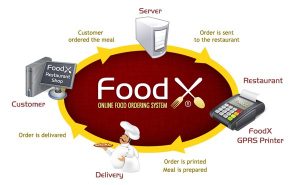Bricks and Clicks Business Model
Retail reinvention is an ongoing process which is not so simple. Brick and mortar B&M refers to a physical presence of an organization or business in one or more buildings or other structure. The term brick-and-mortar business is often used to refer to a company that possesses buildings; often including retail stores, production facilities, or warehouses for its operations. In contrast to brick-and-mortar, online shops have no physical presence for shoppers, such online businesses normally have non-public physical facilities from which they either run business operations.
Bricks and clicks is a term for a business model by which a company integrates both offline (bricks) which means shops and stores plus online (clicks) presences. Additionally sometimes retailers add a few extra flips added such as catalogue, telephone ordering and mobile phone apps and telephone sales support. The initiation of mobile web has made businesses operating bricks and clicks businesses very popular, because it means customers can do tasks like shopping when they have spare time and do not have to be at a computer. Most of the bricks and clicks customers like to use mobile shopping sites. A common example of the bricks and clicks model is when a chain of stores allows the customer to order products both online and physically in one of their stores, also allowing them to either pick-up their order directly at a local branch of the store or get it delivered to their home.
The bricks and clicks model has typically been used by traditional retailers who have extensive logistics and supply chains, but are well known and often respected for their traditional physical presence. And, they are famous because it is far easier for a traditional retailer to establish an online presence than it is for a start-up company. It takes years of presence for a retailer to establish a traditional presence, including a strong and well recognized brands, without having a large marketing budget. It can also be said that adoption of a bricks and clicks model where a customer can return items to one of the stores of the organization can reduce costs to a business such as shipping for undelivered and returned items.
PC world is an example of Bricks and Clicks which has both offline and online presence. It provides a range of electronic products but focuses on computers. It is very popular and has numerous stores worldwide. It provides an online e-business system for its customers and clients; to purchase the products online, the customers need to create an account on the stores website. This assists the store in keeping a record and allows the company to keep track of the purchases and payment being made. The financial transactions over the website consists data on the customer as they have proof of the card holders identity which helps them to assist customers in managing any fraudulent transactions. The customers also can make purchases in person with cash at the stores and have repair services or exchanges done to products purchased online.
Advantages: bricks and clicks is beneficial to various segments. For example, supermarkets often have different customer types requiring alternative shopping options; one group may wish to see the goods directly before purchase and like the expediency of quickly shopping, while another group may require a different convenience of shopping online and getting the order delivered when it suits them. Thus, having a bricks and clicks model means both customer groups are satisfied.
Disadvantages: A major factor of concern of this business model is cost controlling, as usually maintaining a physical presence and online presence. Also, online shopping makes price comparison easier for customers, this encourages a ‘race-to-the-bottom’, where retailers only compete on price, with quality and service deteriorating as a result. This is especially dominant because online shopping allow prices to be compared without even visiting a retailer’s website.
The prices listed online many times does not match the prices listed offline. The reasons for this include mismanagement, and managing overhead cost due to the logistic difference between an online purchase and an offline purchase. An online purchase sometimes results in confusion and deviations of expectations for the buyers. Many retailers shy away from this model because It has been observed that a bricks and clicks business model is quite difficult to implement.
Legalities: This model allows customers to purchase goods or services remotely, hence it is legislated in many jurisdictions which grant more rights to consumers. In the UK, for example, any goods purchased online of a bricks and clicks business allows the buyer protection under the Consumer Protection (Distance Selling) Regulations 2000 Act, which allows the consumer to return a product or cancel a service within 14 days of purchase for a full refund. Similar rights are awarded in EU countries. In the USA, the Federal Trade Commission legislate allows consumers 3 days to return items ordered over web if they are not satisfied. A British clothing retailer named ‘Next’ was fined for demanding return postage cost from one of their customers.
Channel conflicts: Many Bricks and Clicks retailers have experienced conflicts with their marketing channels, especially with their offline retailers and agents, for example, Compaq feared that its retailers would drop its line of computers If Compaq offered to sell the same computer directly online. Merrill lynch hesitated to introduce online stock trading to compete with ET-Trade, Schwab, and other online brokerages fearing that its own brokers would rebel. Barnes & Noble which is the largest book retailer delayed opening an online site which they did with lot of thinking for giving fight to Amazon. The reason these companies struggled opening on-line sites is the question of how to conduct online sales without cannibalizing their own stores, resellers, franchises, stockiest and agents.
Conclusion: Many companies such as British retailer John Lewis has found success in adopting a bricks and clicks business model, with the online ordering service beating brick and mortar sales. Online auction website eBay has also launched a scheme in cooperation with catalogue shop Argos that allows goods sold by third parties to be collected in a brick-and-mortar location, which allows the customer to collect goods at their convenience rather than wait at home for a delivery company. On the other hand, HMV music retailer went into losses in 2013, despite having operated both brick-and-mortar stores and an online presence. It went into losses due to high overheads of operating the brick-and-mortar side of the business making HMV unable to compete with pure-clicks retailers such as Amazon.com.
Paying for many physical store premises and their staffing requires larger capital expenditure which online only businesses do not usually have. On the other hand, a business selling more luxurious, often expensive, or occasionally purchased products like cars are more common with a physical presence, due to physical attributes being more considered while making the purchasing decision. But, car manufacturers such as Dacia have introduced online configurators that allow a customer to configure and order complete cars online. They visit a dealer only to collect the completed car, and friends this has proven popular with customers.















































